椭圆轨迹振动切削加工
- 格式:pdf
- 大小:7.66 MB
- 文档页数:16
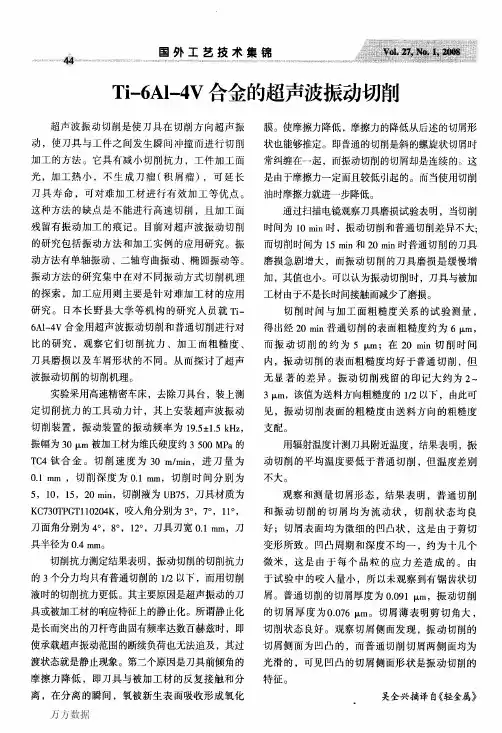
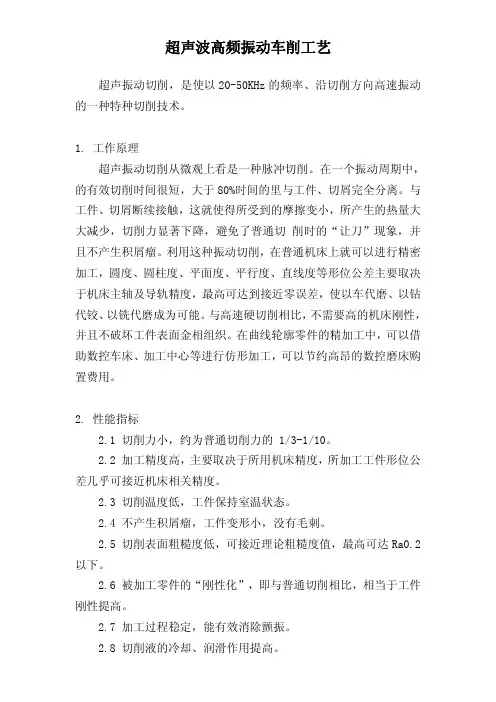
超声波高频振动车削工艺超声振动切削,是使以20-50KHz的频率、沿切削方向高速振动的一种特种切削技术。
1.工作原理超声振动切削从微观上看是一种脉冲切削。
在一个振动周期中,的有效切削时间很短,大于80%时间的里与工件、切屑完全分离。
与工件、切屑断续接触,这就使得所受到的摩擦变小,所产生的热量大大减少,切削力显著下降,避免了普通切削时的“让刀”现象,并且不产生积屑瘤。
利用这种振动切削,在普通机床上就可以进行精密加工,圆度、圆柱度、平面度、平行度、直线度等形位公差主要取决于机床主轴及导轨精度,最高可达到接近零误差,使以车代磨、以钻代铰、以铣代磨成为可能。
与高速硬切削相比,不需要高的机床刚性,并且不破坏工件表面金相组织。
在曲线轮廓零件的精加工中,可以借助数控车床、加工中心等进行仿形加工,可以节约高昂的数控磨床购置费用。
2.性能指标2.1切削力小,约为普通切削力的1/3-1/10。
2.2加工精度高,主要取决于所用机床精度,所加工工件形位公差几乎可接近机床相关精度。
2.3切削温度低,工件保持室温状态。
2.4不产生积屑瘤,工件变形小,没有毛刺。
2.5切削表面粗糙度低,可接近理论粗糙度值,最高可达Ra0.2以下。
2.6被加工零件的“刚性化”,即与普通切削相比,相当于工件刚性提高。
2.7加工过程稳定,能有效消除颤振。
2.8切削液的冷却、润滑作用提高。
2.9耐用度呈几倍到几十倍提高。
2.10被加工表面呈压应力状态,零件疲劳强度、耐磨性、耐腐蚀性提高。
2.11切削后的工件表面呈彩虹效果。
3.应用范围由于超声振动切削有如此多的优点,所以可广泛应用于航空、航天、军工等领域各种难加工材料的切削加工。
3.1难加工材料切削:如耐热钢、钛合金、恒弹性合金、高温合金、不锈钢、冷硬铸铁、工程陶瓷、复合材料和花岗岩等。
3.2加工淬硬钢零件及超硬零件,能得到很高的加工精度和表面质量:用硬质合金可以很轻松地加工硬度达HRC60以上的淬硬钢零件,如高速钢、轴承钢等;用PCD加工硬质合金,可以大大提高的耐用度。
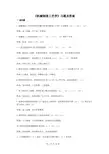
《机械制造工艺学》习题及答案一填充题1 机械制造工艺学的研究对象主要是机械加工中的三大问题即(a),(b),(c)。
答案:加工质量、生产率、经济性。
2 机械加工工艺系统包括(a),(b),(c),(d)等四个方面。
答案:机床、夹具、工件、刀具。
3 工艺过程划分加工阶段的原因是:(a),(b),(c),(d)。
答案:提高加工质量、合理利用机床、安排热处理工序、及早发现毛坯缺陷。
4 在机械制造中,通常将生产方式划分为(a),(b),(c)三种类型。
答案:单件小批、中批、大批大量生产。
5 确定毛坯加工余量的方法有三种即(a),(b),(c)。
大批量生产用(d)。
答案:计算法、查表法、经验估计法、计算法。
6 根据作用的不同,基准通常可分为(a)和(b)两大类,定位基准属于(c)。
答案:设计基准、工艺基准、工艺基准。
7 为了保证加工质量,安排机加工顺序的原则是(a),(b),(c),(d)。
答案:先面后孔、先粗后精、先主后次、先基面后其它。
8 选择定位粗基准要考虑(1)使各加工面都有一定的和比较均匀的(a);(2)保证加工面与非加工面的(b)。
答案:加工余量、相互位置精度。
9 零件的加工精度包括三方面的内容即(a),(b),(c)。
答案:尺寸精度、几何形状精度、表面相互位置精度10 零件表层的机械物理性质包括(a ),(b),(c)。
答案:表面冷硬、表层残余应力、表层金相组织11 刀具磨损属于(a )误差,可以通过计算后输入(b )来补偿。
答案:变值系统误差、等值异号的误差12 零件的表面质量包括(a),(b),(c)、(d)。
答案:表面粗糙度及波度、表面冷硬、表层残余应力、表层金相组织13 工艺系统的振动分为两大类即(a)与(b),其中振幅随切削用量而变的是(c)。
答案:强迫振动、自激振动、自激振动14 切削加工后,引起表面残余应力的主要原因有(a),(b),(c)。
答案:塑性变形、温度变化、金相组织变化15 精密机床加工精度零件为了减少热变形,加工前应具备两条:(a),(b )。
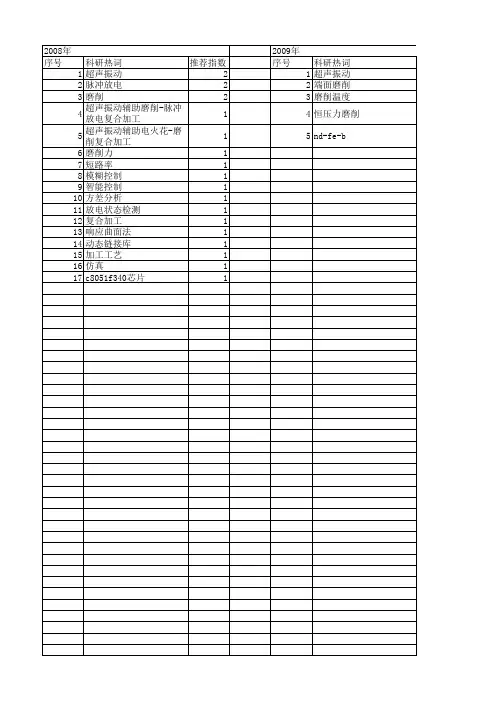
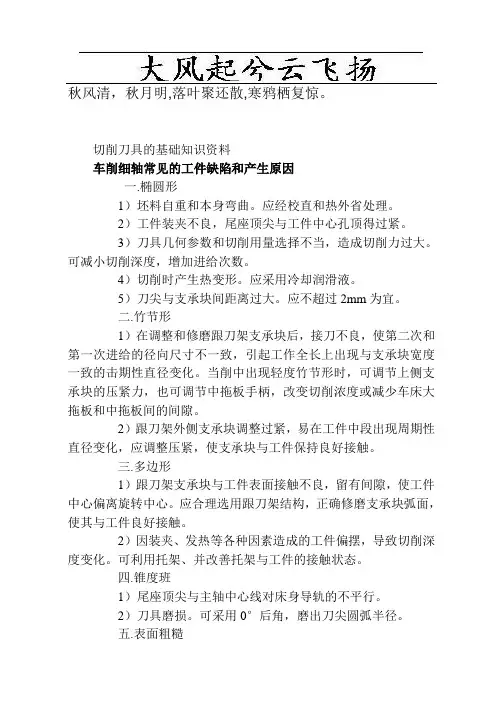
秋风清,秋月明,落叶聚还散,寒鸦栖复惊。
切削刀具的基础知识资料车削细轴常见的工件缺陷和产生原因一.椭圆形1)坯料自重和本身弯曲。
应经校直和热外省处理。
2)工件装夹不良,尾座顶尖与工件中心孔顶得过紧。
3)刀具几何参数和切削用量选择不当,造成切削力过大。
可减小切削深度,增加进给次数。
4)切削时产生热变形。
应采用冷却润滑液。
5)刀尖与支承块间距离过大。
应不超过2mm为宜。
二.竹节形1)在调整和修磨跟刀架支承块后,接刀不良,使第二次和第一次进给的径向尺寸不一致,引起工作全长上出现与支承块宽度一致的击期性直径变化。
当削中出现轻度竹节形时,可调节上侧支承块的压紧力,也可调节中拖板手柄,改变切削浓度或减少车床大拖板和中拖板间的间隙。
2)跟刀架外侧支承块调整过紧,易在工件中段出现周期性直径变化,应调整压紧,使支承块与工件保持良好接触。
三.多边形1)跟刀架支承块与工件表面接触不良,留有间隙,使工件中心偏离旋转中心。
应合理选用跟刀架结构,正确修磨支承块弧面,使其与工件良好接触。
2)因装夹、发热等各种因素造成的工件偏摆,导致切削深度变化。
可利用托架、并改善托架与工件的接触状态。
四.锥度班1)尾座顶尖与主轴中心线对床身导轨的不平行。
2)刀具磨损。
可采用0°后角,磨出刀尖圆弧半径。
五.表面粗糙1)车削时的振动。
2)跟刀架支承块材料选用不当,与工件接触和磨擦不良。
3)刀具几何参数选择不当。
可磨出刀尖圆弧半径,当工件长度与直径比较大时亦可采用宽刃低速光车。
刀具损坏形式计算机辅助分析系统的开发1 引言切削加工是机械加工中应用最广泛的加工方法之一,目前零件的最终形成仍以切削加工为主。
切削加工过程中的刀具损坏有磨损和破损两种方式。
刀具的磨损是由于工件—刀具—切屑接触区发生强烈摩擦,造成刀具表面(前、后刀面)的材料被切屑或工件逐渐带走,刀具的磨损形式包括前刀面磨损(月牙洼磨损)、后刀面磨损、边界磨损、刀尖磨损等。
刀具的破损是由于刀具设计、制造及使用不当或刀具(尤其是一些脆性刀具材料如陶瓷刀具)受切削力冲击而发生损坏,刀具破损分早期和后期破损,有崩刃、剥落、碎断和裂纹等形式。
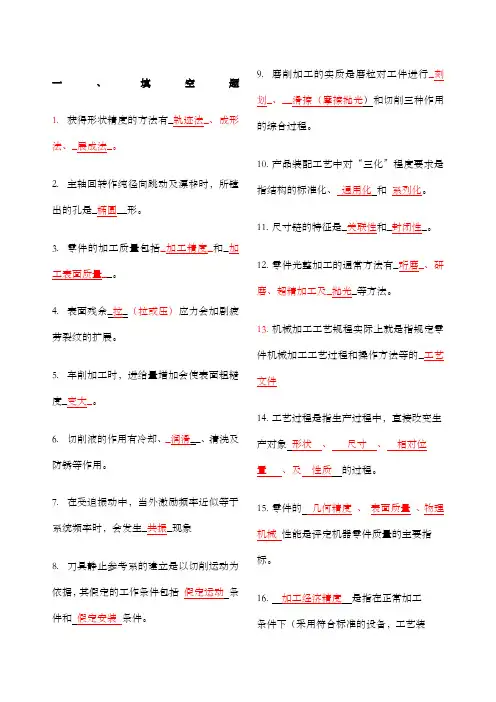
一、填空题1.获得形状精度的方法有_轨迹法_、成形法、_展成法_。
2.主轴回转作纯径向跳动及漂移时,所镗出的孔是_椭圆__形。
3.零件的加工质量包括_加工精度_和_加工表面质量__。
4.表面残余_拉_(拉或压)应力会加剧疲劳裂纹的扩展。
5.车削加工时,进给量增加会使表面粗糙度_变大_。
6.切削液的作用有冷却、_润滑__、清洗及防锈等作用。
7.在受迫振动中,当外激励频率近似等于系统频率时,会发生_共振_现象8.刀具静止参考系的建立是以切削运动为依据,其假定的工作条件包括假定运动条件和假定安装条件。
9.磨削加工的实质是磨粒对工件进行_刻划_、__滑擦(摩擦抛光)和切削三种作用的综合过程。
10.产品装配工艺中对“三化”程度要求是指结构的标准化、通用化和系列化。
11.尺寸链的特征是_关联性和_封闭性_。
12.零件光整加工的通常方法有_珩磨_、研磨、超精加工及_抛光_等方法。
13.机械加工工艺规程实际上就是指规定零件机械加工工艺过程和操作方法等的_工艺文件14.工艺过程是指生产过程中,直接改变生产对象形状、尺寸、相对位置、及性质的过程。
15.零件的几何精度、表面质量、物理机械性能是评定机器零件质量的主要指标。
16.加工经济精度是指在正常加工条件下(采用符合标准的设备,工艺装备和标准技术等级的工人,不延长加工时间)所能保证的加工精度。
17.工艺系统的几何误差主要加工方法的原理误差、制造和磨损所产生的机床几何误差和传动误差,调整误差、工件的安装误差、刀具、夹具和量具由于的制造误差与磨损引起。
18.轴类零件加工中常用两端中心孔作为统一的定位基准。
19.零件的加工误差指越小(大),加工精度就越高(低)。
20.粗加工阶段的主要任务是获得高的生产率。
21.工艺系统的几何误差包括加工方法的原理误差、制造和磨损所产生的机床几何误差和传动误差,调整误差、刀具、夹具和量具的制造误差、工件的安装误差。
22.精加工阶段的主要任务是使各主要表面达到图纸规定的质量要求。
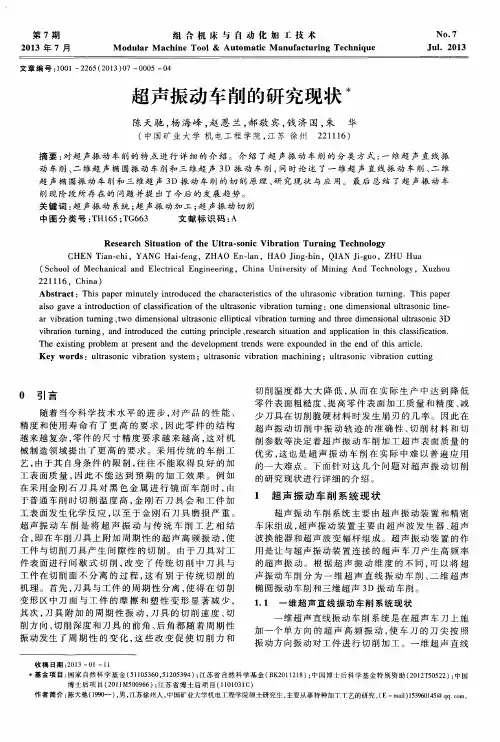
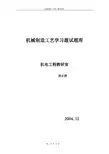
机械制造工艺学习题试题库机电工程教研室孙正烈2004.12目录一填充题 (3)二选择题 (7)三问答题 (9)四分析题 (16)五计算题 (25)六计算实例 (40)一填空题1 机械制造工艺学的研究对象主要是机械加工中的三大问题即(a),(b),(c)。
答案:加工质量、生产率、经济性。
2 机械加工工艺系统包括(a),(b),(c),(d)等四个方面。
答案:机床、夹具、工件、刀具。
3 工艺过程划分加工阶段的原因是:(a),(b),(c),(d)。
答案:提高加工质量、合理利用机床、安排热处理工序、及早发现毛坯缺陷。
4 在机械制造中,通常将生产方式划分为(a),(b),(c)三种类型。
答案:单件小批、中批、大批大量生产。
5 确定毛坯加工余量的方法有三种即(a),(b),(c)。
大批量生产用(d)。
答案:计算法、查表法、经验估计法、计算法。
6 根据作用的不同,基准通常可分为(a)和(b)两大类,定位基准属于(c)。
答案:设计基准、工艺基准、工艺基准。
7 为了保证加工质量,安排机加工顺序的原则是(a),(b),(c),(d)。
答案:先面后孔、先粗后精、先主后次、先基面后其它。
8 选择定位粗基准要考虑(1)使各加工面都有一定的和比较均匀的(a);(2)保证加工面与非加工面的(b)。
答案:加工余量、相互位置精度。
9 零件的加工精度包括三方面的内容即(a),(b),(c)。
答案:尺寸精度、几何形状精度、表面相互位置精度10 零件表层的机械物理性质包括(a ),(b),(c)。
答案:表面冷硬、表层残余应力、表层金相组织11 刀具磨损属于(a )误差,可以通过计算后输入(b )来补偿。
答案:变值系统误差、等值异号的误差12 零件的表面质量包括(a),(b),(c)、(d)。
答案:表面粗糙度及波度、表面冷硬、表层残余应力、表层金相组织13 工艺系统的振动分为两大类即(a)与(b),其中振幅随切削用量而变的是(c)。
答案:强迫振动、自激振动、自激振动14 切削加工后,引起表面残余应力的主要原因有(a),(b),(c)。
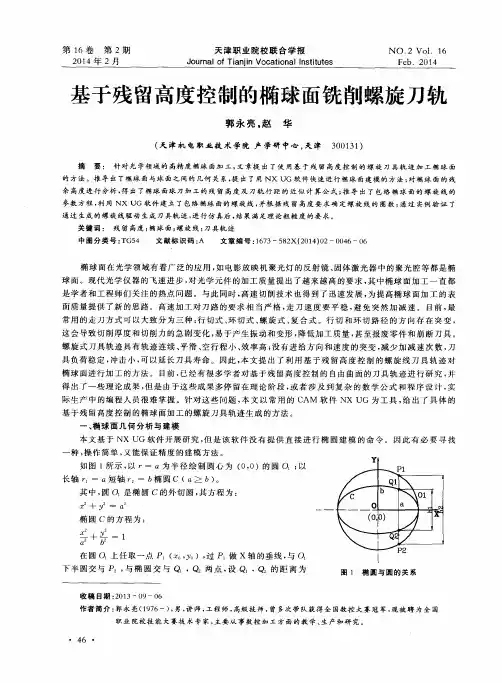
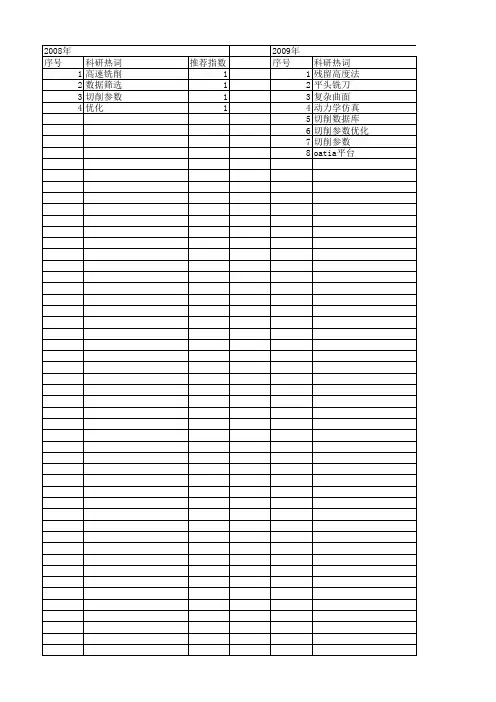
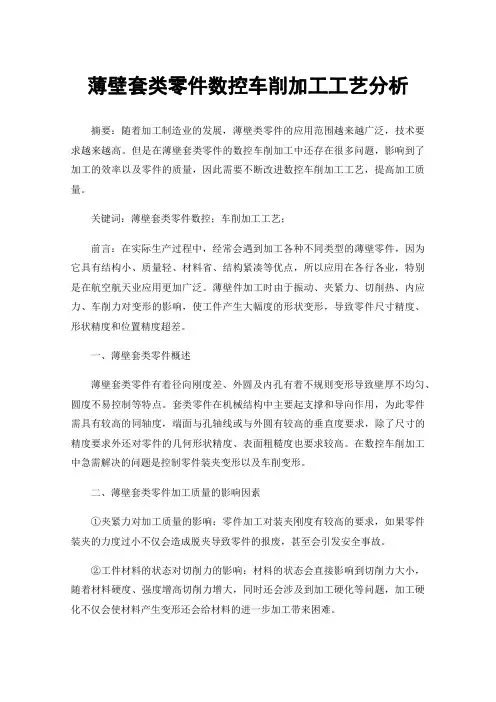
薄壁套类零件数控车削加工工艺分析摘要:随着加工制造业的发展,薄壁类零件的应用范围越来越广泛,技术要求越来越高。
但是在薄壁套类零件的数控车削加工中还存在很多问题,影响到了加工的效率以及零件的质量,因此需要不断改进数控车削加工工艺,提高加工质量。
关键词:薄壁套类零件数控;车削加工工艺;前言:在实际生产过程中,经常会遇到加工各种不同类型的薄壁零件,因为它具有结构小、质量轻、材料省、结构紧凑等优点,所以应用在各行各业,特别是在航空航天业应用更加广泛。
薄壁件加工时由于振动、夹紧力、切削热、内应力、车削力对变形的影响,使工件产生大幅度的形状变形,导致零件尺寸精度、形状精度和位置精度超差。
一、薄壁套类零件概述薄壁套类零件有着径向刚度差、外圆及内孔有着不规则变形导致壁厚不均匀、圆度不易控制等特点。
套类零件在机械结构中主要起支撑和导向作用,为此零件需具有较高的同轴度,端面与孔轴线或与外圆有较高的垂直度要求,除了尺寸的精度要求外还对零件的几何形状精度、表面粗糙度也要求较高。
在数控车削加工中急需解决的问题是控制零件装夹变形以及车削变形。
二、薄壁套类零件加工质量的影响因素①夹紧力对加工质量的影响:零件加工对装夹刚度有较高的要求,如果零件装夹的力度过小不仅会造成脱夹导致零件的报废,甚至会引发安全事故。
②工件材料的状态对切削力的影响:材料的状态会直接影响到切削力大小,随着材料硬度、强度增高切削力增大,同时还会涉及到加工硬化等问题,加工硬化不仅会使材料产生变形还会给材料的进一步加工带来困难。
③刀具角度对工件的影响:前角大时,切削变形量和摩擦力减小,切削力减小,表面粗糙度好;前角过大,刀具楔角减小,刀具强度降低,散热能力差,磨损速度快,刀具使用寿命降低;后角大,与工件切削表面间隙大,摩擦力小,切削力也相应的减小;后角过大,会形成刀具刃部变薄,强度不足,磨损速度快,刀具使用寿命降低。
④吃刀量与进给速度对切削力的影响:背吃刀量与切削速度对切削力的交互影响当背吃刀量为常数时,切削速度增大时,切削力变化的幅度不是很大;而当切削速度为常数时,背吃刀量增大,切削力增大较明显[3]。
Journal of Materials Processing Technology 214(2014)2644–2659Contents lists available at ScienceDirectJournal of Materials ProcessingTechnologyj o u r n a l h o m e p a g e :w w w.e l s e v i e r.c o m /l o c a t e /j m a t p r o t ecFundamental investigation of ultra-precision ductile machining of tungsten carbide by applying elliptical vibration cutting with single crystal diamondJianguo Zhang,Norikazu Suzuki ∗,Yilong Wang,Eiji ShamotoDepartment of Mechanical Science and Engineering,Nagoya University,Furo-cho,Chikusa-ku,Nagoya 464-8603,Japana r t i c l ei n f oArticle history:Received 19November 2013Received in revised form 30April 2014Accepted 20May 2014Available online 9June 2014Keywords:Elliptical vibration cutting Ductile machining Tungsten carbideMaterial composition Tool wear Sculpturinga b s t r a c tThis paper presents essential investigations on the feasibility of ductile mode machining of sintered tungsten carbide assisted by ultrasonic elliptical vibration cutting technology.It lays out the foundations toward efficient application of elliptical vibration cutting technology on tungsten carbide.Tungsten car-bide is a crucial material for glass molding in the optics manufacturing industry.Its grain size and binder material have significant influence not only on the mechanical and chemical properties but also on the machining performance of tungsten carbide.In order to investigate the influence of material compo-sition on tungsten carbide machining,a series of grooving and planing experiments were conducted utilizing single crystal diamond tools.The experimental results indicated that as compared to ordinary cutting where finished surface deteriorates seriously,ductile mode machining can be attained success-fully by applying the elliptical vibration cutting technique.It was also clarified that the binder material,the grain size,cutting/vibration conditions as well as crystal orientation of the diamond tool have sig-nificant influence on the tool life and the machined surface quality.Based on these fundamental results,feasibility of micro/nano-scale fabrication on tungsten carbide is investigated.By applying amplitude con-trol sculpturing method,where depth of cut is arbitrary changed by controlling the vibration amplitude while machining,ultra-precision textured grooves and a dimple pattern were successfully sculptured on tungsten carbide in ductile mode.©2014Elsevier B.V.All rights reserved.1.IntroductionWith the rapidly developing optoelectronics industry,demand for advanced manufacturing technology for sophisticated micro/nano structures on optical systems is increasing drastically.For example,glass lenses with small radius and large curvature have been used in various devices to miniaturize their structures and/or to attain large storage capacity.Some micro/nano optical gratings have been used in optical communication equipments,encoders,and digital cameras.In order to realize mass production of those glass devices,tungsten carbide is heavily used in molding because of its unique mechanical,thermal and chemical properties.Ultra-precision cutting has been generally applied to fabricate sophisticated micro/nano structures,and it has been widely used∗Corresponding author.Tel.:+81527894491;fax:+81527893107.E-mail addresses:nuzhjg@upr.mech.nagoya-u.ac.jp (J.Zhang),nsuzuki@mech.nagoya-u.ac.jp (N.Suzuki),wang@upr.mech.nagoya-u.ac.jp (Y.Wang),shamoto@mech.nagoya-u.ac.jp (E.Shamoto).especially for a variety of plastic molding applications.However,application of ultra-precision cutting to brittle materials is limited.Since tungsten carbide is a typically hard and brittle material,its ductile machining is extremely difficult by the ordinary ultra-precision cutting technology due to generations of brittle fracture in the workpiece and excessive tool damage.Bulla et al.(2012)reported the feasibility of ultra-precision diamond turning in ductile mode on binderless,nano crystalline tungsten carbide.However,tool wear is not negligible and thus the cutting area is extremely restricted.In contrast to cutting,ultra-precision grind-ing is applicable to ductile mode machining of tungsten carbide,as reported by Yin et al.(2004).Suzuki et al.(2008)has applied the grinding technology successfully in particular applications.Suzuki et al.(2010)additionally reported that following lapping and/or polishing are also effective to achieve higher quality surface finish.However it is extremely difficult to fabricate sophisticated micro/nano-scale structures especially with sharp edges by these methods.In addition,the conventional ultra-precision grinding operation is generally time-consuming as compared to cutting operation due to its complexity.These facts impose significant/10.1016/j.jmatprotec.2014.05.0240924-0136/©2014Elsevier B.V.All rights reserved.J.Zhang et al./Journal of Materials Processing Technology214(2014)2644–26592645restrictions in practical use of tungsten carbide and define the bottleneck of ultra-precision machining of tungsten carbide.In the last few decades,ultrasonic vibration cutting technology has been successfully applied to difficult-to-cut materials machin-ing,as reviewed by Brehl and Dow(2008).In particular,elliptical vibration cutting technology,which was proposed by Shamoto and Moriwaki(1994),has been the foreseen alternative to attain ultra-precision machining of hard brittle materials.Moriwaki and Shamoto(1995)developed ultrasonic elliptical vibration cutting devices,and Shamoto and Moriwaki(1999)verified the feasibil-ity of steel material machining by use of single crystal diamond (SCD)tools.Brehl and Dow(2007)challenged to create complex micro-structures by utilizing the elliptical vibration cutting tech-nology.Zhang et al.(2011)conducted further investigations on machining performance of hardened steel using polycrystalline diamond(PCD)tools.On the other hand,Suzuki et al.(2004)have applied the elliptical vibration cutting technology to machining of tungsten carbide with Cobalt binder,and its ductile machin-ing has been attained successfully by applying SCD tools.Suzuki et al.(2006)investigated the fundamental mechanism of ductile machining of tungsten carbide by applying elliptical vibration cut-ting as well.However,the tool damage has been significant unlike hardened steel machining,and thus the cutting area was restricted to be extremely small.Nath et al.(2009a)also carried out several experimental investigations on elliptical vibration cutting of sin-tered tungsten carbide,where machinability of tungsten carbide by using PCD tools was investigated.Following this,the influence of the cutting parameters and tool radius on machined surface qual-ity was further investigated by Nath et al.(2009b).Consequently, Nath et al.(2009c)concluded that restriction in the cutting area is improved successfully by using PCD tools and a surface with roughness of less than30nm Ra was attained at the beginning of cutting.However,surface roughness deteriorates significantly, which may not be acceptable in manufacturing of optical elements. This fact indicates that further research contribution to extend the tool life of SCD is necessary to realize practical machining of tungsten carbide by applying the elliptical vibration cutting tech-nology.On the other hand,tungsten carbide material has been studied and developed with better properties by modifying the material composition and the grain size.Material property affects machin-ing characteristics of tungsten carbide significantly at the same time.For instance,material strength depends on the grain size and binder material,which may have chemical affinity to diamond.The material strength and the chemical affinity have major influence on tool wear.Jia and Fischer(1996)conducted a series of scratch tests of tungsten carbide with cobalt binder by means of a modified Vickers hardness tester,where significant advantage of small-sized grain in abrasion resistance was clarified.Paul et al.(1996)reported significance of chemical aspect of tool wear in cutting with SCD tools.Saito et al.(2006)studied the influences of cobalt content and grain size on the wear resistance of tungsten carbide against carbon steel in their abrasion experiments,where the wear rate increased with cobalt content and grain size of tungsten carbide.Krakhmalev et al.(2007)also studied abrasion wear process of tungsten car-bide against silicon carbide abrasive.Ren et al.(2009)investigated influence of grain size and cobalt binder on grinding process.Zhang et al.(2012)also addressed experimental investigation to evaluate the influence of material composition on the cutting performance with SCD tools.Nevertheless,few researchers have investigated the influence of material composition on ultra-precision machining of sintered tungsten carbide so far.Further study on tungsten carbide machining considering material technology may lead to significant machining performance increase.In order to investigate the possibility to extend tool life in the elliptical vibration cutting of tungsten carbide,comprehensive study on machinability of tungsten carbide is carried out in this paper.A series of fundamental cutting tests are conducted and the influence of material properties,cutting and vibration condi-tions and crystal orientation of single crystal diamond tools are investigated.Through analysis of experimental results,the influ-ence of the binder material composition and the grain size of tungsten carbide on the machining performance of the ellipti-cal vibration cutting with SCD tools are studied.Based on these fundamentalfindings,feasibility of ultra-precision machining of tungsten carbide with micro/nano-scale structures,i.e.,textured grooves and a dimple pattern,are explored.Henceforth,the paper is organized as follows.The elliptical vibration cutting process is explained in Section2,followed by experimental conditions in Section3,and results of fundamental grooving and planing experiments in Section4.Finally,nano-sculpturing applications are presented in the following section.The paper is concluded with a summary.2.Elliptical vibration cutting processFig.1shows a schematic illustration of the elliptical vibration cutting process.The diamond tool is fed at a nominal cutting speed, and the tool tip is generally controlled to vibrate elliptically in the plane determined by the nominal cutting direction and the depth of cut direction.In the present study,the nominal cutting speed is set to be lower than the maximum vibration speed ensuring that the tool is separated from the workpiece in each vibration cycle.As shown in Fig.1,in a cycle of the elliptical vibration,the cutting starts from point A,and then the workpiece material is removed in the form of a chip.After the tangent of the tool trajectory becomes parallel to the rake face,the cutting tool separates from the chip at point B.Because of this intermittent process,reduction in the chip thickness and cutting forces can be attained.Due to this separation in each vibration cycle,the cutting tool and the work-piece can be cooled by the surrounding air and/or the cuttingfluid. This also allows suppression of adhesion between the tool and the workpiece.As a result,the thermo-chemical wear is supressed effi-ciently.Because of these characteristics,ultra-precision machining of hardened steel can be attained,as reported in Brinksmeier and Gläbe(2001).Suzuki et al.(2007)also clarified that ultra-precision machining of tungsten alloy becomes feasible due to the same reason.Kim and Loh(2007)clarified that this process is also advan-tageous to fabricate micro structures due to small cutting force and less burr formation.Fig.2illustrates the elliptical vibrator and its control system for the elliptical vibration cutting.It was designed as a two-degree-of-freedom(2-DOF)elliptical vibrator and was developed by the authors.The vibrator can be actuated by exciting PZT actuators that are sandwiched with metal cylindrical parts.Since the vibrator is designed to have the same resonant frequencies in thesecond Fig.1.Elliptical vibration cutting process.2646J.Zhang et al./Journal of Materials Processing Technology 214(2014)2644–2659Table 1Types of tungsten carbide materials used in cutting experiments.NO.Average grain size (m)Binder phaseHardness (GPa)Elastic modulus (GPa)BL10.3Binderless,Co(≤0.2wt%)25.48675BL20.5Binderless,Co(≤0.2wt%)23.52680BL3 1.3–1.5Binderless,Co(≤0.2wt%)19.60650BL40.3Binderless,Co(≤0.1wt%)25.98680Co10.5Co(≤10wt%)19.60560Co2 1.3–1.5Co(≤10wt%)13.72560Co30.5Co(12wt%)17.30580Ni10.5Ni(≤10wt%)16.66510resonant mode of longitudinal vibration and the fifth resonant mode of bending vibration,it can generate large longitudinal and bending vibrations simultaneously at the same ultrasonic frequency by exciting the actuators.As a result,a 2-DOF elliptical vibration can conveniently be obtained at the diamond tool tip.Vibration amplitudes can be adjusted arbitrary within 4m p-p by controlling the amplifier gains as shown in Fig.2.3.Experimental conditions to study on machinability of tungsten carbide3.1.Workpieces and diamond toolsThis section introduces the workpieces and diamond tools uti-lized in various cutting experiments to investigate the cutting performance of tungsten carbide.Eight kinds of workpieces with different binder materials and grain size are prepared for exper-imental investigations.The material properties including catalog values of hardness and elastic modulus are listed in Table 1.Before the machining experiments,all workpieces are ground to make flat surfaces.Note that the subsurface damage has significant influence on the machining performance of tungsten carbide.Therefore,lap-ping with fine abrasives is followed to make a flat mirror surface and to remove subsurface damage from the workpiece surfaces.The tool used in these experiments is a SCD tool with a nose radius of 1mm,a clearance angle of 10◦and a negative rake angle of −20◦.The crystal orientation of the flank face is set to be (100),while that of the rake face is set to be (100)or (110).These com-binations are denoted as R (100)F (100)and R (110)F (100)in this paper,where ‘R ’and ‘F ’represent the rake face and the flank face,respectively.Fig.2.2-DOF elliptical vibration tool.3.2.Experimental setup and cutting conditionsThis section presents the experimental setup used in grooving and planing.All experiments are performed on an ultra-precision machine tool,whose positioning resolution is 1nm.The 2-DOF elliptical vibrator,which can generate arbitrary elliptical vibration at a frequency of about 36.2kHz,was attached to the X axis table.Fig.3shows the experimental setup.In order to investigate the influence of the depth of cut on the machined surface quality,the cutting feed is controlled by the synchronized motion of the X axis table and the Z axis table.The depth of cut was linearly increased in grooving and planing,as illustrated in Fig.3.Experimental con-ditions are summarized in Table 2.4.Grooving and planing experimentsparison of elliptical vibration cutting with ordinary cuttingAt first,investigations are undertaken to compare elliptical vibration cutting performance with ordinary cutting.The binder-less workpiece of BL4is grooved by the ordinary cutting and the elliptical vibration cutting.Fig.4shows the scanning elec-tron microscope (SEM)images of the grooved surface on BL4at a depth of cut of 0.2m.In these experiments,the nominal cut-ting speed is set to 150mm/min.Amplitudes of elliptical vibration in the nominal cutting and depth of cut directions A c and A d are set to 4m p-p and 2m p-p to realize an elliptical vibration locus.As noted from Fig.4,the groove formed by the ordinary cutting is filled with numerous brittle defects.In contrast,a smooth sur-face can be obtained by the elliptical vibration cutting.As no brittle crack and asperity can be observed on the surface in the elliptical vibration cutting,ductile mode machining was attained success-fully.From this fact,it can be expected that the inside of tungsten carbide grains existing at the topmost layer of the remained surface was cut without fracture generation on the surface or pull-out of the grains,which are observed in the ordinary cutting.Next,Fig.5shows the cutting edges after grooving of the binder-containing workpiece of Co1.Considerable adhesion of the workpiece material can be observed on the rake face of the tool used in ordinary cutting,which may result in adhesion wear and/or considerable thermo-chemical reaction.The same phenomena was observed in the ordinary cutting of other binder-containingTable 2Experimental conditions for grooving and planing.Elliptical vibration conditionsFrequency [kHz]:36.2Amplitude in nominal cutting direction [m p-p ]:2–4Amplitude in depth of cut direction [m p-p ]:1–4Phase shift [◦]:90Cutting conditionsDepth of cut [m]:0–maximum 2Cutting speed [mm/min]:137.5–1100Pick feed for planing [m]:5Cutting fluid:oil moistening (Bluebe LB-10)J.Zhang et al./Journal of Materials Processing Technology 214(2014)2644–26592647Fig.3.Illustration and picture of experimentalsetup.Fig.4.SEM images of grooved surface (workpiece:BL4,depth of cut:0.2m,nominal cutting speed:150mm/min).materials.On the other hand,no adhesion was observed in the elliptical vibration cutting.This fact indicates that the ellipti-cal vibration cutting may be effective to suppress tool wear progress and to attain better surface quality in machining of binder-containing tungsten carbide as well as steel materials.Mechanism of the ductile mode machining shown in Fig.4is considered as follows.In elliptical vibration cutting,the toolcutsFig.5.Cutting edges after grooving (workpiece:Co1).the surface that is finished in the previous vibration cycle.Thus,the actual uncut chip,i.e.,instantaneous uncut chip thickness shown in Fig.1,becomes extremely thin.Note that this uncut chip thickness becomes generally smaller as compared with the nominal depth of cut.The instantaneous uncut chip thickness in each vibration cycle becomes significantly small especially when the tool cuts the finished surface around the bottom of the elliptical vibration.Because of this process,the actual depth of cut becomes smaller than the critical value for ductile machining due to the size effect in fracture toughness,resulting in significant improvement of nominal critical depth of cut for ductile machining of tungsten carbide.The process is similar to that in milling,and Arif et al.(2012)clarified similar improvement in milling process through experiments with the PCD tool.4.2.Influence of cutting parameters on surface qualityIn this section,the influence of several cutting parameters,i.e.,vibration amplitudes,depth of cut,and nominal cutting speed,on the surface quality is investigated in an empirical manner.Firstly,fundamental micro grooving experiments were carried out under several conditions.Fig.6demonstrates the surface quality of micro grooves machined on Co1where the nominal cutting speed and vibration amplitudes in the nominal cutting and depth of cut direc-tions,A c and A d ,are changed.The speed ratio,i.e.,the ratio of the maximum vibration speeds in the nominal cutting direction to the nominal cutting speed,is kept to be a constant value of 25.The grooved surfaces at the vibration amplitudes A c –A d of 4–4m p-p and 2–2m p-p are filled with micrometer-scale brittle defects,as shown in Fig.6.The defect size is several times larger than the single grain size of 0.5m.Thus,these defects are con-sidered to be due to the pull-out of agglomerated tungsten carbide2648J.Zhang et al./Journal of Materials Processing Technology 214(2014)2644–2659Fig.6.Influence of vibration amplitude on surface quality (workpiece:Co1,depth of cut:0.9m,amplitudes in nominal cutting and depth of cut directions:A c –A d m p-p ,nominal cutting speed:v c mm/min).grains from the workpiece surface.On the other hand,similar large defects do not generate at vibration amplitudes of 4–2and 2–1m p-p .Similar experimental results were also observed in case of other binder-containing and binderless materials and hence it can be concluded that the influence of vibration amplitudes on ductile machining is not negligible.The influence of the depth of cut on the surface quality was also investigated.Fig.7demonstrates a groove surface of BL4,which was machined with a circular vibration (2m p-p )at a nominal cutting speed of 150mm/min.The depth of cut is gradually increased from 0m to 2m.Surface quality changes depending on the depth of cut,where brittle cracks can generate at a large depth of cut even in the elliptical vibration cutting.Transition border from ductile to brittle modes are observed at the depth of cut of about 1.5m.Agglomerated grains seem to be pulled out at one time from the surface,and this feature of the defects is the same as that shown in Fig.6.This kind of defect characterized by their size is definedas “multi-grain-size defect”in this paper.Note that similar surface deterioration with large defects is not observed in ordinary cut-ting.Hence,this is considered to be a specific problem in elliptical vibration cutting.These amplitude and depth of cut dependencies are considered to be related to the chip pulling-up-motion in the elliptical vibra-tion cutting.Fig.8shows schematic illustrations of the elliptical vibration cutting process.When the vibration amplitude is larger in the depth of cut direction,chip pulling-up-distance in this direction becomes longer.In addition,the chip pulling-up-distance increases up to about half the amplitude when the depth of cut is large.Sintered materials are not tough against tensile stress.Because of this nature,massive grains may be pulled out from the workpiece surface by the pulling-up-motion especially when upward motion distance in the depth of cut direction is longer than the grain size.When the ratio of amplitude in the depth of cut direction to that in nominal cutting direction is large,the slope of the cutting edge trajectory becomes steep while pulling up the chip.This steep tra-jectory is also considered to enhance the above-mentioned pull-out phenomena.Hence,the vibration amplitudes and the depth of cut need to be selected properly to avoid the “multi-grain-size defect”occurrence due to the pull-out of massive grains.The influence of the nominal cutting speed on the surface quality is also examined by conducting several grooving experiments.SEM images of the machined surfaces of BL1at a depth of cut of 0.5m are shown in Fig.9.It is confirmed that higher quality surfaces in the ductile mode can be attained at lower nominal cutting speed.On the contrary,poor surfaces with a number of defects were observed distinctively at higher nominal cutting speed.The defect size is less than several hundred nanometers,which is almost identical to the grain size.Experiments performed on other workpieces indicated a similar tendency.To differentiate from “multi-grain-size defect”,this kind of defect is defined as “single-grain-size defect”in the present research.This cutting-speed dependency of surface quality is considered to be associated with the cut volume in each vibra-tion cycle.It should be noted that the instantaneous uncut chip thickness is almost proportional to the nominal cutting speed.Thus,the cutting forces decrease and the strain energy at the deformed zone is reduced when the nominal cutting speed decreases.Small force and strain energy are beneficial to suppress crack propaga-tions while machining.Hence,the selection of the cutting speed condition is significantly important to suppress “single-grain-size defect”occurrence.Fig.7.Machined groove with the increasing of depth of cut (workpiece:BL4,amplitudes:2–2m p-p ,nominal cutting speed:150mm/min).J.Zhang et al./Journal of Materials Processing Technology 214(2014)2644–26592649Fig.8.Pull up motion with different vibrationamplitudes.Fig.9.Effect of nominal cutting speed on surface quality (workpiece:BL1,amplitudes:4–2m p-p ,depth of cut:0.5m).Fig.10.SEM micrographs of machined groove surface (depth of cut:0.9m,vibration amplitudes:2–1m p-p ,nominal cutting speed:137.5mm/min).4.3.Influence of binder material and grain size on cutting performancesGrooving experiments are also conducted on tungsten carbide with different binder content and grain sizes,such as BL1,Co1,BL2,BL3and Co2.SEM images of grooved surfaces of BL1and Co1are shown in Fig.10.As noted,brittle cracks are not observed from themachined surfaces.This also indicates that ductile mode machin-ing is realized at a large depth of cut of 0.9m.However,ductile machining was not realized by the same cutting conditions in BL2,BL3and Co2even when the depth of cut is smaller.This can be validated from Fig.11.Their surfaces are filled with the single-grain-size defects due to brittle fracture,which were observed in the high-cutting-speed machiningexperiment.Fig.11.Brittle fracture of machined groove surface (depth of cut:0.2m,vibration amplitudes:2–1m p-p ,nominal cutting speed:137.5mm/min).2650J.Zhang et al./Journal of Materials Processing Technology214(2014)2644–2659Comparing the grooving results of BL1,BL2and BL3,the dif-ference in surface integrity indicates that smaller grain size is advantageous to attain ductile mode machining.It is known that sintered materials consisting of smaller particles generally have better toughness due to smaller initial defect size inside the mate-rial,as reported by Fang and Eason(1995).Because of this nature,finer grain is advantageous not only to increase the toughness of the material but also to realize ductile mode paring the grooving results of Co1and BL2,it is apparent that the binder phase is also advantageous to suppress the generation of brittle fracture.The defect size is,therefore,smaller in Co2than that in BL3,where the grain sizes are the same.The same advantage in fracture suppression was confirmed in Ni1.4.4.Analysis of fundamental grooving experimentsThrough the grooving experiments,we found that single-grain-size defects can be generated much more easily as compared to multi-grain-size defects.Therefore,it is important to select appropriate process conditions focusing upon suppression of the single-grain-size defect generation.In order to evaluate the rel-ative difference in surface deterioration due to single-grain-size defects,the machined surface quality was classified into nine lev-els and a scale from0to8are provided by the authors based on optical microscope observation.0represents the best surface with minimal defects and8is associated with the worst surfacefinish. Yan et al.(2009)developed a similar method to evaluate surface integrity of silicon carbide machined by SCD tools.Unlike the SEM observation,single-grain-size defects are simply observed as asperities or hazes by means of an optical microscope due to insufficient resolution.However,it is considered to be avail-able to evaluate an extent of single-grain-size defects from the observed optical images.In the present study,machined surfaces are observed by an optical microscope.Then,optical micrographs of the machined surfaces with a size of250×250pixels were processed using the data processing software,MATLAB.One pixel size is0.18m×0.18m.As the defect area becomes darker than the smooth area without defects,the darker portion is identi-fied as the defect surface.By counting the total number of pixels identified as a defect,the scores of the machined surfaces are eval-uated.For instance,high quality surfaces of BL1and Co1shown in Fig.10are indexed as0and1where no single-grain-size defect is observed.As compared with Co1,the score of the machined surface of BL1is judged as0because of the smoother surface.Scores of the machined surfaces of BL2,BL3and Co2in Fig.11are evaluated as 5,8,and6due to the single-grain-size defect.This quantification process might be influenced by the threshold in data processing, but relative difference in the evaluation results seem to be mostly reliable.As mentioned above,surface deterioration due to single-grain-size defects may depend on the instantaneous uncut chip thickness in elliptical vibration cutting process.In particular,the maximum instantaneous uncut chip thickness while cutting thefinished surface is considered to be directly associated with surface dete-rioration.Fig.12illustrates the tool trajectory around the bottom and the theoretical maximum instantaneous uncut chipthickness Fig.12.Maximum instantaneous uncut chip thickness while cuttingfinished sur-face.Fig.13.Influence of maximum instantaneous uncut chip thickness on surface qual-ity(evaluated at a depth of cut of about1m).at the i-th cycle.By considering the kinematic model of ellipti-cal vibration cutting,Table3summarizes the calculated values of the maximum instantaneous uncut chip thickness in the grooving experiments.Fig.13indicates relations of surface quality score and maxi-mum instantaneous uncut chip thickness for all evaluated materials in grooving.The values of surface quality index increase with an increase of maximum instantaneous uncut chip thickness regard-less of the workpiece material.Hence,the maximum instantaneous uncut chip thickness needs to be decreased to achieve better sur-face quality.High quality surfaces in ductile mode,whose score is0or1,are obtained when the maximum instantaneous uncut chip thickness is less than or equal to4nm and the workpieces are BL1,BL4,Co1,Co3,and Ni1.In other words,ductile machin-ing cannot be attained for Co2,BL2and BL3under all evaluated conditions.These facts indicate that appropriate vibration ampli-tude and cutting speed conditions need to be selected to satisfy a small maximum instantaneous uncut chip thickness,which is less than or equal to4nm.The grain size also needs to be less than or equal to0.5m and binder material is helpful to attain ductile mode machining.The feature of multi-grain-size defect occurrence is almost the same as that of the single-grain-size defect occurrence.Table3Values of maximum instantaneous uncut chip thickness in grooving experiments[nm].Vibration amplitudes in nominal cutting/depth of cut directionsm p-p4/44/24/12/22/1Nominal cutting speed [mm/min]137.5210.542 275842168 550321686231 11001246231––。